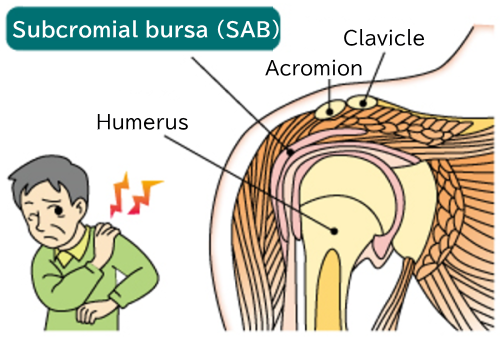Frozen shoulder
It is a common disorder that causes pain, stiffness and loss of normal range of motion in the shoulder. It affects mainly people aged 40 to 60. It is differentiated from rotator cuff or calcific tendonitis.

Symptoms:
Aches from the shoulder to the arm
Difficulty to raise the arm
Dull ache, sharp pain
Distracted sleep due to pain
Difficulty to reach behind or/and out to the side: Eg) difficulty crossing/drying the clothes, putting a belt around or folding an apron backside
Symptoms occur in different shoulder motions
What causes pain? What bring the loss of motion?
Frozen shoulder is commonly caused by inflammation of the capsule, the tissues surrounding the shoulder joint. Normally the capsule has folds that expand and contract as the arm moves. But in frozen shoulder, the capsule becomes inflamed, and scars are made.
Once scars are developed, the joint feels pain and becomes tightened, and these result in the loss of motion.
It is not known exactly what causes the condition, however, one of the reasons is the gradual loss of quality and motion of the shoulder joint due to degeneration/aging.
Also repeated movements or poor posture of the body, bringing negative effects on pelvic, chest, and spine, may increase the risk of developing frozen shoulder. Having limited motions in these parts, the shoulder joints are inclined to overwork and put extra burden on themselves. These adverse consequences may cause inflammation and scars on the capsule, then the muscles around the joint attempt to limit the movements. Finally, you have pain, stiffness and the loss of motion.
Treatments:
Medications: Anti-inflammatory medications, injection to reduce inflammation
Physical therapy: Exercises to decrease the stiffness around the joint and to free tendon adhesion
Surgery: Surgery is proposed for severe or persistent symptoms
Shoulder Diseases

We provide explanations for various shoulder conditions. Please use this as a general guide to determine which condition may apply to you.
- Common shoulder injuries by age group
- To those who neither have frozen shoulder nor rotator cuff tears
- Throwing Shoulder Disorder
- Rotator Cuff Tears and Rotator Cuff Injuries
- Recurrent Shoulder Dislocation
- Frozen Shoulder
- Shoulder Dislocation
- Acromioclavicular Joint Dislocation
- Chronic Acromioclavicular Joint Dislocation
- Frozen Shoulder
- Calcific Tendinitis of the Rotator Cuff
- Primary Degenerative Shoulder Arthritis
- Rotator Cuff Tear-related Degenerative Shoulder Arthritis
- Non-traumatic Shoulder Instability
- Biceps Tendon Injuries
- Surgical Trends for Throwing Shoulder in Baseball Players
